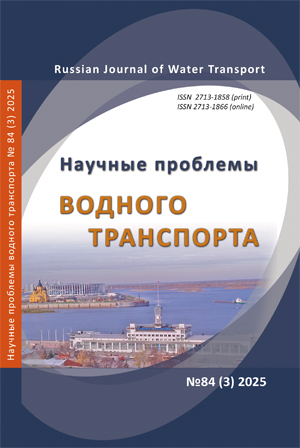Choice of the mechanical testing to plot the dependence of the microhardness of metal on the plastic strain
Abstract
The comparative analysis of the results of the tests on uniaxial compression and uniaxial tension of the metal alloys was caried out. The goal of the analysis was to reveal the advantages and disadvantages of the tests in terms of using them to plot the calibration dependence of microhardness on the plastic strain. There were four alloys tested: copper, brass L60, steel 15 and aluminum-magnesium alloy AMg5. There were from 8 to 12 cylindrical samples tested on uniaxial compression. The compression of each sample was conducted to different strain value. Being compressed the samples were cut either along the section containing the axis of a cylinder, or perpendicularly to the axis of the compressed cylinder in the middle of the cylinder height. The testing on the tension was carried out until failure; then the two parts of the broken specimens of the copper, brass L60 and steel 15 were cut along the axis. The surfaces of the sections was first ground on the abrasive paper of different grit, and then polished on the wet cloth with polishing paste. And on the torn samples of the alloy AMg5 the zone of the uniform deformation was marked and cut into a few cylindrical samples of the length-to-diameter ratio equal to 2, the cylindrical samples were subjected to plastic deformation in uniaxial compression and then the deformed samples were cut either along the section containing the axis of a cylinder, or perpendicularly to the axis of the compressed cylinder in the middle of the cylinder height. The obtained sections were ground and polished. The measurements of the microhardness of the sections obtained were conducted. The measurements for the compressed specimens were performed in the center of the section; for the torn specimens — along the axis on the different distances from the specimen butt. The microhardness was measured using three loads on the indentor: 0,196 N; 0,490 N and 0,980 N. There were produced 6 impressions on each load, that is 18 impressions in all. The final value of microhardness was obtained as mean arithmetical magnitude over 18 impressions. For the most alloys it does not matter which testing to apply — uniaxial compression or uniaxial tension — in order to obtain the calibration dependence of microhardness on the plastic strain for the zone of strain not exceeding 0,3, the uniaxial compression being preferable as less costly. In the area of comparatively high plastic strains to avoid the considerable error in evaluation of the strain distribution in plastically deformed parts according to the microhardness measurements it is recommended to plot the calibration curve based on the uniaxial compression tests.
References
Genov G. Revisiting the rule-of-thumb dependencies of the shear strength and the hardness on the yield and the ultimate strengths // Technical Report. 2020. 7 p. DOI:10.13140/RG.2.2.24105.72807.
Zhang Ch., Li F., Wang B. Estimation of the elasto-plastic properties of metallic materials from micro-hardness measurements // Journal of material science. 2013. Vol. 48. P. 4446–4451. doi 10.1007/s10853-01307263-3.
Goanta V. Plastic deformation degree based on Vickers hardness test near the fractured sur-faces for determining J1C / Proceedings of the 5th International Conference on Integrity-Reliability-Failure. Topic C: Fracture and Fatigue. 2016. Paper ref. 6207. P. 165–178.
Jang J. Estimation of residual stress by instrumented indentation: A review // Journal of Ce-ramic Processing Research. 2009. Vol. 10. No 3. P. 391–400.
Цветков Ю. Н. Разложение остаточных напряжений в стальных напыленных покрытиях на структурную и термическую составляющие методом микротвердости// Заводская лаборатория. Диагностика материалов / 2005. Т. 71. № 10. С. 46-50.
Kim J.-Y., Kang S.-K., Greer J. R., Kwon D. Evaluating plastic flow properties by charac-terizing indentation size effect using a sharp indentor // Acta Materialia. 2008. Vol. 56. P. 3338–3343. doi:10.1016/j.actamat.2008.02.049.
Branch N. A., Subhash G., Arakere N. K., Klecka M. A. A new reverse analysis to deter-mine the constitutive response of plastically graded case-hardened bearing steels // Interna-tional Journal of Solids and Structures. 2011. Vol. 48. P. 584–591. doi:10.1016/j.ijsolstr.2010.10.023.
Дель Г. Д. Определение напряжений в пластической области по распределению твёр-дости. М.: Машиностроение, 1971. 199 с.
Yu X., Qiao D., Crooker P., David S., Feng Zh. Measurements of plastic strain distribution in dissimilar metal weld by microhardness mapping // Proceedings of the ASME 2014 Pres-sure Vessels and Piping Conference. 2014, Anaheim, California, USA. P. 1–4.
Погодаев Л. И., Шевченко П. А. Гидроабразивный и кавитационный износ судового оборудования. Л.: Судостроение, 1984. 263 с.
Цветков Ю. Н., Погодаев Л. И. Напряжённое состояние металлов при изнашивающем воздействии абразива. СПб.: СПбГУВК, 2004. 94 с.
Robinson J. N., Shabaik A. H. The determination of the relationship between strain and mi-crohardness by means of visioplasticity // Metallurgical transactions. 1973. Vol. 4. P. 2091–2095.
Sonmez F. O., Demir A. Analytical relations between hardness and strain for cold formed parts // Journal of Material Processing Technology. 2007. Vol. 186. P. 163–173. doi: 10.1016/j.jmatprote.2006.12.031.
Ramaekers J. A. H., Veenstra P. C. The relation between effective deformation and micro-hardness in a state of large plastic deformation // Annals of the C.I.R.P. 1970. Vol. XVIII. P. 541–545.
Малинин Н. Н. Прикладная теория пластичности и ползучести. М.: Машиностроение, 1975. 400 с.
Смирнов-Аляев Г. А. Механические основы пластической обработки металлов. Л.: Машиностроение, 1968. 272 с.
Вичужанин Д. И., Шихов С. Е., Смирнов С. В., Чурбаев Р. В. Влияние напряженного состояния на предельную пластичность медной катанки М00К // Известия вузов. Цветная металлургия. 2015. №5. С. 39–45. DOI: dx.doi.org/10.17073/0021-3438-2015-5-39-45.
Zhang X. W., Wen J. F., Zhang X. C., Wang X. G., Tu S. T. Effects of the stress state on plastic deformation and ductile failure: Experiment and numerical simulation using a newly designed tension‐shear specimen // Fatigue and Fracture of Engineering Materials and Structures. 2019. P. 1–14. DOI: 10.1111/ffe.13084.
Copyright (c) 2025 Russian Journal of Water Transport

This work is licensed under a Creative Commons Attribution 4.0 International License.













